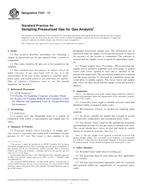Potřebujeme váš souhlas k využití jednotlivých dat, aby se vám mimo jiné mohly ukazovat informace týkající se vašich zájmů. Souhlas udělíte kliknutím na tlačítko „OK“.
ASTM D5544-11
Standard Test Method for On-Line Measurement of Residue After Evaporation of High-Purity Water
Automaticky přeložený název:
Standardní zkušební metoda pro on-line měření zbytkem po odpaření z vysoce čisté vody
NORMA vydána dne 1.5.2011
Informace o normě:
Označení normy: ASTM D5544-11
Poznámka: NEPLATNÁ
Datum vydání normy: 1.5.2011
Kód zboží: NS-31615
Počet stran: 9
Přibližná hmotnost: 27 g (0.06 liber)
Země: Americká technická norma
Kategorie: Technické normy ASTM
Kategorie - podobné normy:
Anotace textu normy ASTM D5544-11 :
Keywords:
high-purity water, nonvolatile residue, residue after evaporation, Colloidal dispersions, Contamination--water, Dissolved elements (of water), High-purity water, Inorganic compounds--water, Nonvolatile residue (NVR), Organic compounds--water, Residue, Residue after evaporation (RAE), Semiconductors--water applications, ICS Number Code 71.040.40 (Chemical analysis)
Doplňující informace
| Significance and Use | ||||||||||||||
|
Even so-called high-purity water will contain contaminants. While not always present, these contaminants may contribute one or more of the following: dissolved active ionic substances such as calcium, magnesium, sodium, potassium, manganese, ammonium, bicarbonates, sulfates, nitrates, chloride and fluoride ions, ferric and ferrous ions, and silicates; dissolved organic substances such as pesticides, herbicides, plasticizers, styrene monomers, deionization resin material; and colloidal suspensions such as silica. While this test method facilitates the monitoring of these contaminants in high-purity water, in real time, with one instrument, this test method is not capable of identifying the various sources of residue contamination or detecting dissolved gases or suspended particles. This test method is calibrated using weighed amounts of an artificial contaminant (potassium chloride). The density of potassium chloride is reasonably typical of contaminants found in high-purity water; however, the response of this test method is clearly based on a response to potassium chloride. The response to actual contaminants found in high-purity water may differ from the test method's calibration. This test method is not different from many other analytical test methods in this respect. Together with other monitoring methods, this test method is useful for diagnosing sources of RAE in ultra-pure water systems. In particular, this test method can be used to detect leakages such as colloidal silica breakthrough from the effluent of a primary anion or mixed-bed deionizer. In addition, this test method has been used to measure the rinse-up time for new liquid filters and has been adapted for batch-type sampling (this adaptation is not described in this test method). Obtaining an immediate indication of contamination in high-purity water has significance to those industries using high-purity water for manufacturing components; production can be halted immediately to correct a contamination problem. The emerging nano-particle technology industry will also benefit from this information. |
||||||||||||||
| 1. Scope | ||||||||||||||
|
1.1 This test method covers the determination of dissolved organic and inorganic matter and colloidal material found in high-purity water used in the semiconductor, and related industries. This material is referred to as residue after evaporation (RAE). The range of the test method is from 0.001 μg/L(ppb) to 60 μg/L (ppb). 1.2 This test method uses a continuous, real time monitoring technique to measure the concentration of RAE. A pressurized sample of high-purity water is supplied to the test method's apparatus continuously through ultra-clean fittings and tubing. Contaminants from the atmosphere are therefore prevented from entering the sample. General information on the test method and a literature review on the continuous measurement of RAE has been published. 1.3 The values stated in SI units are to be regarded as the standard. The values given in parentheses are for information only. 1.4 This standard does not purport to address all of the safety concerns, if any, associated with its use. It is the responsibility of the user of this standard to establish appropriate safety and health practices and determine the applicability of regulatory limitations prior to use. For specific hazards statements, see Section 8. |
||||||||||||||
| 2. Referenced Documents | ||||||||||||||
|
Podobné normy:
Historická
15.12.2008
Historická
1.8.2013
Historická
1.6.2013
Historická
1.11.2008
Historická
1.5.2010
Historická
1.9.2008
Doporučujeme:
Aktualizace zákonů
Chcete mít jistotu o platnosti užívaných předpisů?
Nabízíme Vám řešení, abyste mohli používat stále platné (aktuální) legislativní předpisy.
Chcete vědět více informací? Podívejte se na tuto stránku.



 ASTM E538-98(2008)..
ASTM E538-98(2008).. ASTM F2714-08(2013)..
ASTM F2714-08(2013).. ASTM F307-13
ASTM F307-13 ASTM F327-08
ASTM F327-08 ASTM G106-89(2010)..
ASTM G106-89(2010).. ASTM G120-01(2008)..
ASTM G120-01(2008)..
 Cookies
Cookies
